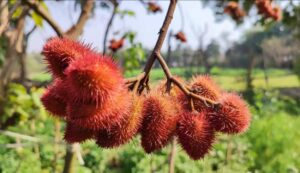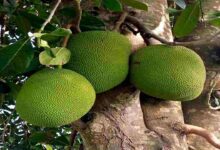Vermilion Farming: Become rich by cultivating vermillion, know how
Vermilion Farming: There are some trees in India’s soil that have a profound impact on many facets of life in addition to being linked to our cultural current. The Sindoor tree, now called Vermilion Farming, is one of them. This tree is famous for its red color and the faith and tradition that accompany it. Today, this tree serves not only as a plant but also as a valuable resource for farmers in regions such as South India, Orissa, West Bengal, and Jharkhand.

A staple of religious ceremonies, the sindoor has come to represent farmers’ wealth. In addition to being inexpensive to cultivate, it yields revenues in the thousands of rupees.
What is a Sindoor tree?
The vermilion tree is mostly found in tropical regions, and its seeds provide a natural color that is utilized in foodstuffs, cosmetics, and medications. ‘Annatto’ is the name of the color that is derived from its seeds and is widely used as a natural color nationwide.
High profit at little cost
For around Rs 30 to Rs 50, a sindoor plant is ready. The sindoor plant requires very little upkeep because it doesn’t need a lot of water, fertilizer, or pesticides to grow. The plant produces fruit for 15 to 20 years after it is planted. Additionally, one acre may accommodate 400–500 trees. A mature tree yields 2 to 3 kilograms of seeds on average per year. These seeds cost between Rs 300 and Rs 500 per kilogram on the market. If one tree generates up to Rs 900 annually, 500 trees could yield a profit of nearly Rs 4.5 lakh annually.
The Sindoor-making process
- Initially, we gather seeds from the fruits of the Bixa plant.
- Sun drying: We leave these seeds out in the sun for a few days to remove the moisture.
- Grinding: We crush the dried seeds to create a crimson powder.
- Purification and filtering: A filter removes contaminants from the powder.
- If necessary, add aromatic and medicinal substances: To make it even more beneficial, add herbs like rose water, sandalwood, camphor, or turmeric.
From regional markets to worldwide demand
While annatto is in high demand on the global market, sindoor cultivation is still quite restricted in India. In many American, Japanese, and European nations, there is a growing desire for natural colors. This might lead to an increase in sindoor production in India.
Government grants and assistance
To encourage sindoor production, certain states’ agricultural agencies are offering marketing assistance, plant distribution, and training. Tribal farmers are increasingly turning to this agriculture, particularly in areas like Chhattisgarh, Jharkhand, and Odisha.

